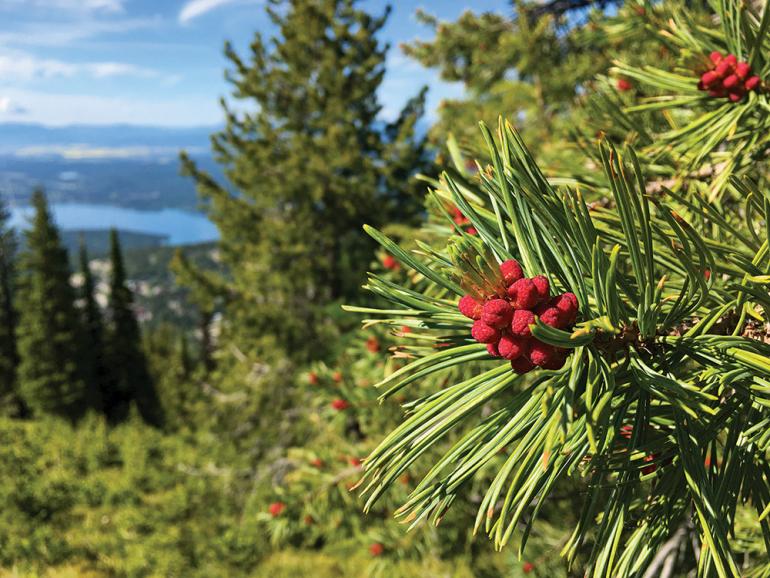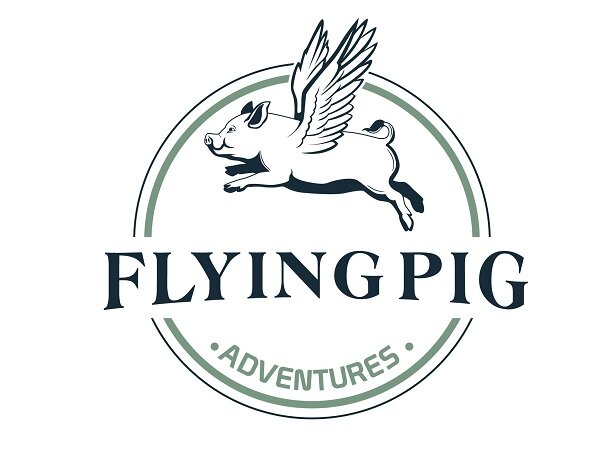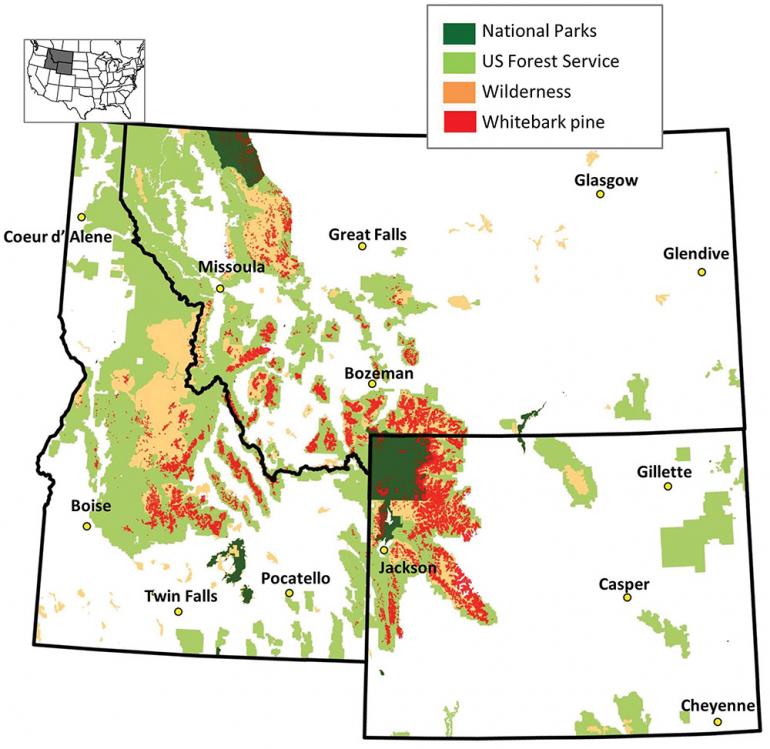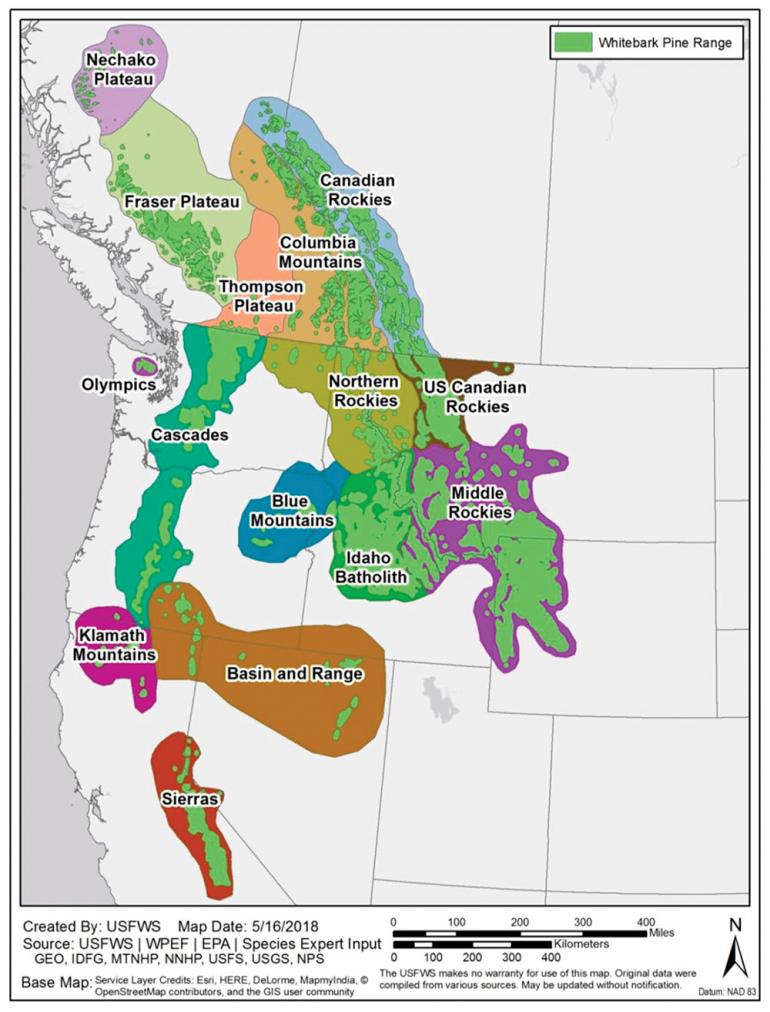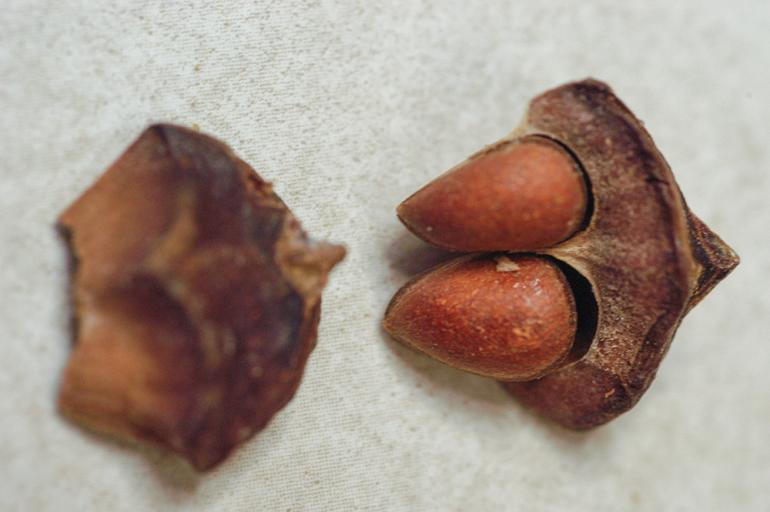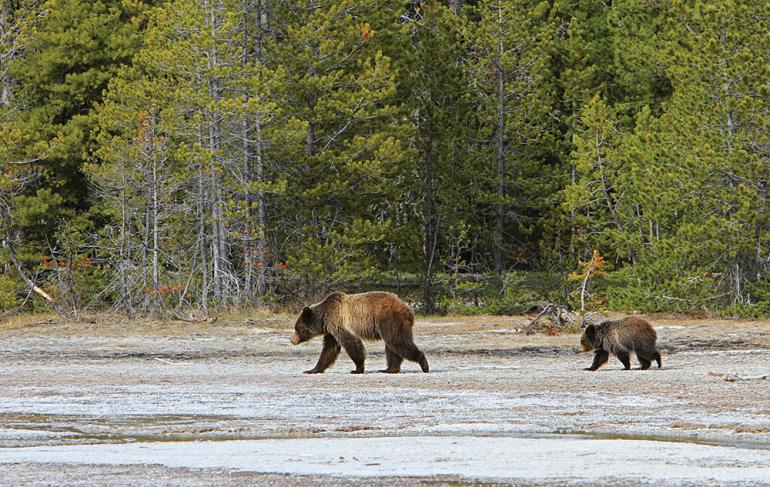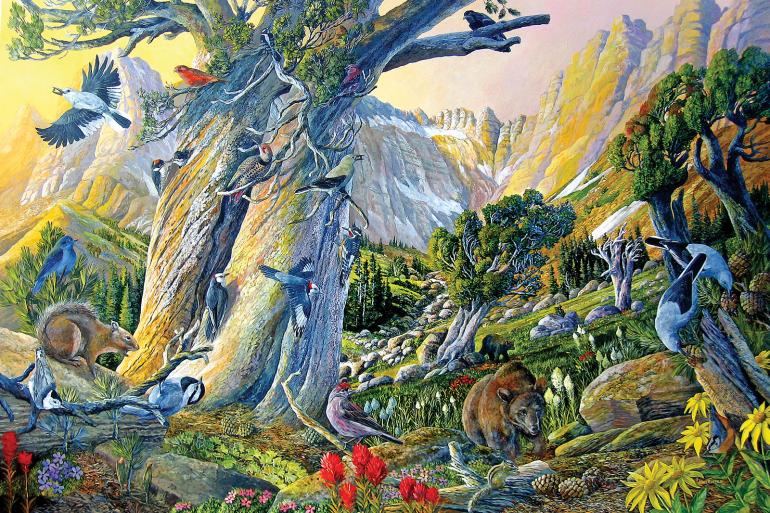Warriors for Whitebark Pine
Behind the big win for an imperiled forest.
I confess to a long love affair with the whitebark pine forests that define the high peaks of the northern Rockies. From alpine summits, mountains recede to the horizon, hinting at the curvature of the Earth. Here, whitebark pines feed and shelter species, large and small, from 600-pound grizzlies to tiny voles.
My heart broke as healthy forests throughout the Greater Yellowstone Ecosystem turned into an ocean of red, dying trees in the blink of an eye, the result of a novel outbreak of native mountain pine beetles during the 2000s. Subsequent investigations have confirmed that whitebark pine has collapsed throughout North America due to the ravages of a nonnative fungal pathogen and an unprecedented outbreak of beetles unleashed by warming temperatures.
In response, the US Fish & Wildlife Service (FWS) proposed in 2020 to protect whitebark pine as a threatened species under the Endangered Species Act (ESA). A final decision is expected in summer 2022.
The FWS proposal brought back memories of the remarkable people that precipitated the ESA listing and their largely unsung efforts to document the catastrophic demise of whitebark pine. Perhaps more importantly, this seemingly obscure campaign for a little-appreciated tree offers important lessons for conservation at a time of unprecedented threats.
Getting Its Due
A federal safety net for whitebark pine could not come at a more critical time. Over 50 percent of whitebark forests in the US have died—and threats are mounting, not just to the trees themselves, but the high-mountain ecosystems they sustain.
So far, efforts to address these threats have been piecemeal. Because the tree has little economic value, its plight has not been a priority for the Forest Service, the agency that manages the lion’s share of whitebark pine forests.
A massive outbreak of pine beetles in Greater Yellowstone during the 2000s galvanized scientists, citizens, nongovernmental organizations, and agency officials, changing the course of whitebark-pine conservation.
The FWS listing proposal was the long-delayed result of a 2008 petition that I helped draft as Senior Wildlife Advocate for the Natural Resources Defense Council (NRDC). Our concerns were reinforced by subsequent surveys of whitebark pine forests. In 2011, the agency responded to our petition by concluding that whitebark pine deserved endangered-species protections. But FWS dodged formally listing the species, claiming that the agency’s limited resources needed to be prioritized for protecting other more critically imperiled species.
A decade later, after updating its analysis and expanding upon our earlier work, FWS agreed with our assessment that the tree is in urgent need of protection.
Creating Ecosystems: From Grizzlies to Trout
Scientists have long been fascinated by the whitebark pine trees that cling to wind-scoured outcrops at the highest elevations of any tree in the northern Rockies, Sierra Nevada, Cascades, and much of interior Alberta and British Columbia. These trees endure bitter cold, icy winds, lightning strikes, and poor soils—even as they create conditions within which other tree species and plants can flourish.
Whitebark pine trees function as the lifeblood of the ecosystems they grow in. These trees play a surprisingly vital role in the hydrology of watersheds by shading and slowing the melt of snow, reducing soil erosion, and regulating streamflows. They sustain the region’s trout fisheries, farms in the valleys below, and the human communities that depend on both. Their fat-rich seeds feed a rich diversity of wildlife, including grizzly bears.
Uphill Battle
The threats to whitebark pine are numerous and complex but climate change looms largest of all. Some models project that we could lose 70 percent or more of the environments cold enough to sustain the species by the end of this century.
Climate change is also driving increasingly frequent and large wildfires that are killing whitebark faster than they can reproduce, while at the same time promoting competitors such as Douglas fir. Warming temperatures have also triggered unprecedented outbreaks of mountain pine beetles. Tragically for whitebark pine, it did not evolve defenses capable of weathering the beetle’s attacks, unlike lower-elevation pines that co-evolved with bark beetles.
Whitebark is also threatened by white pine blister rust, a deadly non-native fungus that was introduced from Asia to North America around the turn of the 20th century. Starting from where it had been introduced along the Pacific Coast, the fungus’ spores traveled far, wiping out some forests entirely.
Over 50 percent of whitebark forests in the US have died—and threats are mounting, not just to the trees themselves, but the high-mountain ecosystems they sustain.
Making matters worse, trees weakened by blister rust become more susceptible to beetle attacks. Meanwhile, in some parts of the northern Rockies, whitebark pines are being crowded out by other conifers following decades of fire suppression.
A Rag-Tag Army Unites
A massive outbreak of pine beetles in Greater Yellowstone during the 2000s galvanized scientists, citizens, nongovernmental organizations, and agency officials, changing the course of whitebark-pine conservation. The crisis catalyzed the formation of a loose-knit coalition focused on assessing the damage and sounding the alarm.
This coalition could not have been more different from the government committees I’d witnessed at the center of managing politicized species such as grizzly bears and wolves—committees that routinely excluded the concerned public. Without money or political agendas at play, however, this new group tended to attract people who were genuinely curious.
At the time, government managers were focused on blister rust: collecting seeds from trees that showed genetic resistance to the disease, and cultivating and planting them to propagate less vulnerable forests. But the beetle outbreak demanded a new approach, one that took the form of a collaborative effort among NRDC, the Forest Service, and the Park Service to aerially assess the damage caused by pine beetles in the Greater Yellowstone ecosystem. Key partners included myself, entomologist and ecologist Jesse Logan, geographer Wally Macfarlane, ecologist Willie Kern, pilot Bruce Gordon of Ecoflight, Liz Davy of the Bridger Teton Forest, and NRDC’s Gaby Chavarria. Our results showed that less than 20 percent of mature whitebark pine forests in Greater Yellowstone were healthy or nearly so, and that only about five percent were completely untouched by beetles. A shocking 80 percent of mature whitebark stands had suffered medium to high levels of beetle-caused mortality.
NRDC also helped convene gatherings of scientists and managers, and hosted events that brought journalists together with lead scientists to tramp through forests of dead and living whitebark pine. Although whitebark is an obscure part of a remote ecosystem, we were able to leverage media interest by connecting its plight with high-profile issues, including grizzly bears.
At the same time, backcountry skiers, outfitters, and other “citizen scientists” began to band together to collect data on the health of these forests. Equipped with cameras, strong legs, and a sense of adventure, people who were often not trained as scientists gathered information about damage to whitebark pine caused by blister rust and beetles. We called ourselves “Whitebark Warriors.”
Our work culminated in the 2008 petition, requesting that the FWS list whitebark pine as endangered throughout its range, a document that, at the time, represented the most comprehensive synthesis of the science on threats to the species.
Tracking a Smoldering Fire
Meanwhile, the beetle outbreak continued as a sneaky, slow burn.
The fate of whitebark pine and its ecosystems hangs in the balance.
Ever the Whitebark Warrior, Wally Macfarlane recently led a massive Forest Service effort to update our 2009 assessment of whitebark pine health. His team found that, although the out-of-control onslaught of beetles had waned, the outbreak continues to simmer—not manifested as in-your-face seas of red, but instead as a slow, deadly burn adding up to more bad news. Even the highest and coldest whitebark forests have not been spared.
With drought and warm temperatures, whitebark pine are stressed, making them more susceptible to beetles, and potentially vulnerable to another massive outbreak.
Roadmap to Recovery
The fate of whitebark pine and its ecosystems hangs in the balance. Climate change is a particularly daunting threat, along with the complex and often surprising synergies among blister rust, wildfire, and beetles that can be enormously hard to predict.
These synergies raise questions about the wisdom of relying on the two approaches that have dominated whitebark-pine conservation so far: planting rust-resistant seedlings, and burning to free the tree from competition by other species.
The ESA provides a roadmap for recovery with the listing of whitebark pine. The principle of precaution is built into the bones of the ESA, an admonition to carefully look at potentially unforeseen consequences before leaping into action and perhaps making a bad situation worse. So is the principle of “do no harm.” Both are vital, given that we humans are notorious for mucking about with good intentions and causing more harm than good. Both principles are especially important in the case of whitebark.
The sight of entire mountain ranges of red, dying forests in and around our oldest national park was hard to ignore.
Intrusive management such as controlled burning can miss the mark—and potentially make matters worse. And building roads to manipulate forests can harm species, such as grizzlies, that depend on remote country. Given the Forest Service’s history on these and similar matters, the FWS must be vigilant to prevent the agency from running amok.
At the same time, there are opportunities to ameliorate losses. Numerous experts believe we should be doing more to offset the reduced resilience in whitebark-pine ecosystems by protecting more lands as Wilderness.
Clearly, no one person or agency has all the answers to the problems facing this important species. Like all people who work for bureaucracies, FWS employees are prone to living in an echo chamber that reinforces their preconceptions and worldviews, an approach that has had problematic consequences for grizzlies and other endangered species. The FWS would be wise to build on our recent history of successful collaboration by constituting a diverse whitebark-pine recovery team with experts on blister rust, beetles, climate change, fire ecology, and forest management from inside and outside government agencies.
The Teaching Tree
Nothing that I’ve described here—including the request for a democratic recovery process—may seem surprising, or even noteworthy. But the successes of our collective efforts to protect whitebark pine are worth examining. They highlight key ingredients for effective conservation, unique in my long career of environmental advocacy.
My experience has taught me that successful conservation isn’t found in a cookbook—e.g., “sue the bastards”—but is, instead, a creative process arising from the involvement of particular people in a particular context. Even so, campaigns such as the one that arose around whitebark pine can offer lessons for those interested in upgrading the practice of conservation.
Here are some of the lessons that stood out to me.
The Power of an Iconic Forest. With whitebark pine, we were blessed with a symbolically-potent landscape. Yellowstone and the West are cultural touchstones. For many, whitebark forests signify high-mountain country, pristine streams, and the freedom of wild places. There is no doubt that iconic species and landscapes can inspire a broad cross-section of people to advocate for positive change.
Minimal Power and Wealth Stakes. Because whitebark grow in remote country and do not make good lumber, loggers have not engaged in the debate over these forests, at least not yet. So far, this has meant less contention than is commonly the case in conservation. As a result, the ideological stakes have also been low, in stark contrast to the bruising battles over grizzlies and wolves, where stakes are extreme. People invested in making money by exploiting nature are powerful, and here, opportunities for collaboration are rare. The lesson is simple: power, wealth, and ideological stakes directly affect opportunities. Admittedly, keeping the stakes low is often out of one’s control.
The Right Ingredients. With whitebark pine, we were also blessed by passion and curiosity shared among leaders in government, academia, NGOs, and volunteer groups. This contributed to a more collaborative atmosphere and a more pragmatic orientation to problems than is typical of most conservation campaigns. Importantly, government leaders were generally friendly, open, and respectful—and eager to solve problems. In addition, funding shortages in the government and academia made collaboration with non-governmental groups imperative. Because no one agency or entity had the resources to adequately address the crisis, we had strong incentives to work together.
A Force for Change Outside Government. Outside the government, the Whitebark Warriors came together as a powerful force for change. Without us, the government almost certainly would not have given the tree the protections it deserved. We were fortunate that the right people showed up at the right time with the right skills, that people got along, and that no one person or organization was invested in being in control and appropriating credit for everything that happened. Decentralized decision-making meant that the work did not flounder on the shoals of organizational jealousies and bureaucracy—scenarios I have seen all too often.
Of Pointy Sticks. This collegial atmosphere raises the question of why we had to file a listing petition. The reasons are straightforward. First, bureaucratic inertia in government is legendary. Second, whitebark pine was not a high-profile species with a loud constituency. Our listing petition helped cut through both complacency and bureaucracy. Even so, the FWS dug its heels in and for nearly three years failed to produce a response to our petition, despite a mandate to do so within one year—and only because the NRDC threatened to sue. Its 2011 finding that the listing of whitebark was warranted meant that the agency had to continue investigating threats—investigations that finally convinced the agency to list the species. As a bottom line, it helps to have a pointy stick, even if the government agents in charge are basically supportive.
Power of the Press. Journalists proved to be powerful allies by helping educate the public about the ecological role of whitebark and the threats to its existence. We were able to leverage reporter interest in climate change and the government’s proposal to remove Yellowstone grizzly-bear protections. The sight of entire mountain ranges of red, dying forests in and around our oldest national park was hard to ignore. Still, positive press about any environmental issue does not fall into your lap. There was no substitute for bringing reporters into these iconic forests in the company of articulate and informed experts
Of Alchemy and the Path Ahead
In my decades of conservation work, I have rarely seen such collective boldness and so little of the kind of lethargy, internecine conflict, and goal inversion that plagues otherwise laudable environmental campaigns. I felt like I was part of an alchemical reaction, as rare and spectacular as the northern lights. The imminent listing of whitebark pine under the ESA opens a new chapter. It remains to be seen whether the can-do spirit I’ve described here will weather the kind of bureaucratic and political traps that often hamper endangered-species recovery, including entrenched views and narrow vision over power and resources. Although more money is clearly needed at this juncture, money can also attract those with ignoble motives.
Whitebark pine is in terrible trouble. At this critical juncture, diverse perspectives and a democratic process tempered with caution and humility promise to advance conservation more effectively than the efforts of one agency operating in a silo. Given the challenges afoot, working to recover these magnificent forests should bring out the best in us, and the government that operates at our behest.
What is at stake is nothing less than the wild heart of our high-mountain country of the West—and an extended ecological family that includes ourselves.
At Natural Resources Defense Council, Sierra Club, Center for Biological Diversity, and Greater Yellowstone Coalition, Louisa Willcox has advocated for the preservation of wilderness and the wild animals of the northern Rockies for over 40 years.



